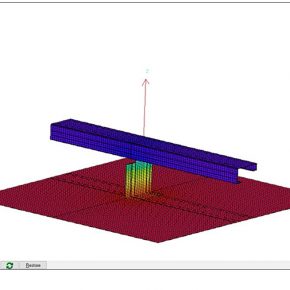
Unintended consequences of cost certainty in public sector construction
GUEST BLOG: Moinak Basu – Architect, HLM
In 2011 the Cabinet Office presented the Government Construction Strategy, which stated: “The industry is provided with sufficient visibility of the forward programme to make informed choices (at its own risk) about where to invest in products, services, technology and skills”.
They equate these elements as the foundations to achieving cost certainty on projects to be delivered in the future.
Now, the government is poised to issue a Building Information Model (BIM) mandate in 2016 and the question that springs to mind is: why does the government feel that a mandate is justified?
 The reasons are numerous. The construction industry suffered heavily in the last recession, with numerous public sector projects being shelved. If a history of cost certainty derived from better efficiencies within the industry had existed, maybe the damage could have been limited.
The reasons are numerous. The construction industry suffered heavily in the last recession, with numerous public sector projects being shelved. If a history of cost certainty derived from better efficiencies within the industry had existed, maybe the damage could have been limited.
Accepting our role in a ‘global economy’, the government is driving the industry to change, by investing more in research and development, and creating marketable skill sets that can sold internationally thereby generating more revenue. This vision essentially lies at the heart of the Government Construction Strategy for 2025, but first we need to re-visit the 2011 strategy.
The Cabinet Office published the Government Construction Strategy in 2011, which acknowledged that the public sector would become more informed and better coordinated when: “its requirements are specified, designed and procured”. It goes on to say that the right model for public sector procurement is one in which the clients issue a brief that concentrates on the required performance and outcome, and that the designers and construction companies should work together to put forward an integrated solution that best meets it. It also echoed the importance of research and innovation around a standardised (or mass customised product).
As an architect I can’t be too thrilled when buildings are described as “mass customised products”, but I definitely understand the government’s overall approach to construction in the public sector in the current economic climate. As an example, such standardised models are being carried out with the 260 schools procured through the Education Funding Agency’s (EFA) Priority Schools Building Programme (PSBP), which are being delivered in five batches.
The strategy also lays down some rules that the industry must be prepared to meet. One of these, a heavily discussed topic, is the delivery of projects through Building Information Modelling (BIM) Level 2. Currently, there are approximately nineteen separate documents that deal with the delivery of a BIM Level 2 project, with some of these documents still being developed and some are quite contradictory.
The 2011 Strategy goes on to say that the: “Government will require fully collaborative 3D BIM (with all project and asset information, documentation and data being electronic) as a minimum [during] 2016”. Naturally there is a sense of anxiety within the wider industry because providing “all project data” (apart from asset information and documentation) in an electronic format is no small task.
There are further challenges when we consider that the government is looking to save money on project costs, which will have an impact on fees and the entire procurement process.
At the heart of this ambition is the 2025 construction strategy, which aims to reduce the delivery time of projects by 50%, reduce costs by 33% and reduce greenhouse gas emissions by 50% — all set out by the 2011 strategy.
As we wait for the mandate, there are still a number of unknowns: whether a coherent set of Employers and Asset Information Requirements and delivery documents (for BIM 2) will be available for the delivery of projects based on performance and optimised asset management as envisioned.
And, what will happen to the 300,000 businesses of which 99.7% are SMEs (based on the 2011 report) — some of whom will not be able to afford the technology or training to become BIM Level 2 accredited when the government finally starts procuring its projects in this manner, in the hope of a bright future.
Latest news

26th July 2024
Enfield Speciality Doors completes world-class project for Atlas Copco HQ
A rundown office and warehouse building completely transformed into a modern headquarters for Atlas Copco has been fitted with more than 120 internal fire doors from Enfield Speciality Doors.
Posted in Access Control & Door Entry Systems, Articles, Building Industry News, Building Products & Structures, Building Systems, Case Studies, Doors, Interior Design & Construction, Interiors, Posts, Restoration & Refurbishment, Retrofit & Renovation, Security and Fire Protection, Sustainability & Energy Efficiency, Timber Buildings and Timber Products, Wooden products
26th July 2024
Abloy UK launches new white paper
Abloy UK, a leading provider of security and access control solutions, has launched a new white paper.
Posted in Access Control & Door Entry Systems, Architectural Ironmongery, Articles, Building Industry News, Building Products & Structures, Building Services, Doors, Facility Management & Building Services, Health & Safety, Information Technology, Innovations & New Products, Publications, Research & Materials Testing, Security and Fire Protection
26th July 2024
MCRMA Member Profile: David Roy, Director of Roofconsult
David Roy of MCRMA member company Roofconsult has more than 50 years’ experience to draw upon working in the building envelope sector and a unique perspective on how it has changed in that time.
Posted in Articles, BIM, Infrastructure & CAD Software, Building Associations & Institutes, Building Industry News, Building Products & Structures, Building Services, Building Systems, Cladding, Information Technology, Restoration & Refurbishment, Retrofit & Renovation, Roofs, Walls
26th July 2024
Strand: Enhancing Door Functionality and Safety
Craig Fox, Sales Director for Strand Hardware, outlines how door industry professionals might apply door limiting stays…
Posted in Architectural Ironmongery, Articles, Building Industry News, Building Products & Structures, Building Services, Doors, Facility Management & Building Services, Health & Safety, Restoration & Refurbishment, Retrofit & Renovation
 Sign up:
Sign up: